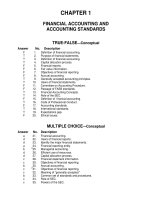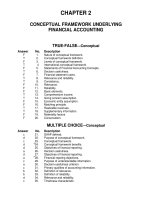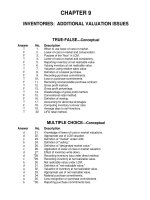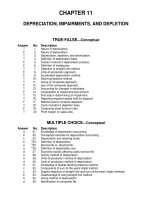Intermediate accounting 16e by kieso slide ch20
Bạn đang xem bản rút gọn của tài liệu. Xem và tải ngay bản đầy đủ của tài liệu tại đây (3.61 MB, 75 trang )
20-1
PREVIEW OF CHAPTER 20
20-2
Intermediate Accounting
16th Edition
Kieso ● Weygandt ● Warfield
20
Accounting for Pensions and
Postretirement Benefits
LEARNING OBJECTIVES
After studying this chapter, you should be able to:
1 Understand the fundamentals
of pension plan accounting.
2 Use a worksheet for employer’s
pension plan entries.
3 Describe the accounting and
amortization of prior service
costs.
20-3
4 Explain the accounting and
amortization for unexpected
gains and losses.
5 Describe the requirements for
reporting pension plans in
financial statements.
LO 1
PENSION PLAN ACCOUNTING
An arrangement whereby an employer provides benefits
(payments) to retired employees for services they provided in
their working years.
Pension
PensionPlan
Plan
Administrator
Administrator
Employer
Employer
Retired
Employees
20-4
Contributions
Benefit Payments
Assets &
Liabilities
LO 1
PENSION PLAN ACCOUNTING
Pension plans can be:
Contributory: employees voluntarily make payments to
increase their benefits.
Noncontributory: employer bears the entire cost.
Qualified pension plans: offer tax benefits.
Pension fund should be a separate legal and accounting
entity.
20-5
LO 1
PENSION PLAN ACCOUNTING
The two most common types of pension plans
are defined contribution plans and defined
benefit plans.
20-6
ILLUSTRATION 20-2
Pension Funds and
Pension Expense
LO 1
PENSION PLAN ACCOUNTING
Defined-Contribution Plan
Employer contribution
determined by plan (fixed)
Risk borne by employees
Benefits based on plan
value
Defined-Benefit Plan
Benefit determined by plan
Employer contribution
varies (determined by
Actuaries)
Risk borne by employer
Actuaries make predictions (called actuarial assumptions) of mortality
rates, employee turnover, interest and earnings rates, early retirement
frequency, future salaries, and any other factors necessary to operate a
pension plan.
20-7
LO 1
WHAT DO THE NUMBERS MEAN? WHICH
PLAN
IS RIGHT
FOR YOU?
WHAT’S
YOUR
PRINCIPLE
Defined contribution plans have become much more popular with employers than
defined benefit plans, as indicated in the chart below. One reason is that they are
cheaper. Defined contribution plans often cost no more than 3 percent of payroll,
whereas defined benefit plans can cost 5 to 6 percent of payroll. The total amount of
pension assets held
by pension plans is
$22,117 billion, which
is 127 percent of gross
domestic product. In
2014, 58 percent of
these assets were in
defined contribution
plans and 42 percent in
defined benefit plans.
Pension plan assets
have grown 6.6 percent
per year over the period
2004–2014.
20-8
Source: Form 5500 filings with U.S. Department of Labor, November 2014, “Private Pension Plan Bulletin.”
LO 1
Measures of the Liability
Two questions:
1) What is the pension obligation that a company should
report in the financial statements?
2) What is the pension expense for the period?
20-9
LO 1
Measures of the Liability
Employer’s pension
obligation is the deferred
compensation obligation it
has to its employees for
their service under the
terms of the pension plan.
Alternative Approaches
FASB’s
choice
20-10
ILLUSTRATION 20-3
Different Measures of the Pension Obligation
LO 1
Measures of the Liability
Recognition of the Net Funded Status of the
Pension Plan
Companies must recognize on their balance sheet the
full overfunded or underfunded status of their defined
benefit pension plan.
The overfunded or underfunded status is measured
as the difference between the fair value of the plan
assets and the projected benefit obligation.
20-11
LO 1
Components of Pension Expense
ILLUSTRATION 20-4
Components of Annual
Pension Expense
20-12
LO 1
Components of Pension Expense
Effect on
Expense
1.
Service Costs
+
Actuarial present value of benefits attributed by the pension
benefit formula to employee service during the period
20-13
LO 1
Components of Pension Expense
Effect on
Expense
2.
Interest on the Liability
+
Interest for the period on the projected benefit obligation
outstanding during the period
The interest rate use is referred to as the settlement rate.
20-14
LO 1
Components of Pension Expense
Effect on
Expense
3.
Actual Return on Plan Assets
+-
Increase in pension funds from interest, dividends, and
realized and unrealized changes in the fair value of the plan
assets.
ILLUSTRATION 20-5
Equation for Computing Actual Return
20-15
LO 1
Components of Pension Expense
Effect on
Expense
4.
Amortization of Prior Service Costs
+
Plan amendments often include provisions to increase
benefits for employee service provided in prior years.
Company allocates the cost (prior service cost) of providing
these retroactive benefits to pension expense in the future,
specifically to the remaining service-years of the affected
employees.
20-16
LO 1
Components of Pension Expense
Effect on
Expense
5.
Gain or Loss
+-
Volatility in pension expense can result from sudden and
large changes in the fair value of plan assets and by changes
in projected benefit obligation.
20-17
LO 1
20
Accounting for Pensions and
Postretirement Benefits
LEARNING OBJECTIVES
After studying this chapter, you should be able to:
1 Understand the fundamentals of
pension plan accounting.
2 Use a worksheet for
employer’s pension plan
entries.
3 Describe the accounting and
amortization of prior service
costs.
20-18
4 Explain the accounting and
amortization for unexpected
gains and losses.
5 Describe the requirements for
reporting pension plans in
financial statements.
LO 2
USING A PENSION WORKSHEET
The “General Journal Entries” columns
determine the journal entries to be
recorded in the formal general ledger.
20-19
The “Memo Record”
columns maintain balances
for the unrecognized
pension items.
LO 2
USING A PENSION WORKSHEET
Illustration: On January 1, 2017, Zarle Company provides the
following information related to its pension plan for the year 2017.
Plan assets, January 1, 2017, are $100,000.
Projected benefit obligation, January 1, 2017, is $100,000.
Annual service cost is $9,000.
Settlement rate is 10 percent.
Actual return on plan assets is $10,000.
Funding contributions are $8,000.
Benefits paid to retirees during the year are $7,000.
Prepare the pension worksheet for 2017.
20-20
LO 2
USING A PENSION WORKSHEET
Prepare a pension worksheet for 2017.
ILLUSTRATION 20-8
($100,000 x 10%)
($1,000) net liability
20-21
LO 2
USING A PENSION WORKSHEET
ILLUSTRATION 20-8
Pension Expense 9,000
Cash
8,000
Pension Asset/Liability
20-22
1,000
LO 2
20
Accounting for Pensions and
Postretirement Benefits
LEARNING OBJECTIVES
After studying this chapter, you should be able to:
1 Understand the fundamentals of
pension plan accounting.
2 Use a worksheet for employer’s
pension plan entries.
3 Describe the accounting and
amortization of prior service
costs.
20-23
4 Explain the accounting and
amortization for unexpected
gains and losses.
5 Describe the requirements for
reporting pension plans in
financial statements.
LO 3
PRIOR SERVICE COST (PSC)
Amortization
Company should not recognize the retroactive benefits as
pension expense in the year of amendment.
Employer should recognize the pension expense over the
remaining service lives of the employees who are expected to
benefit from the change in the plan.
Amortization Method:
20-24
Board prefers a years-of-service method.
Employers may use straight-line amortization over the
average remaining service life of the employees.
LO 3
Years-of-Service Method
Illustration: Assume that Zarle Company’s defined benefit pension
plan covers 170 employees. In its negotiations with the
employees, Zarle Company amends its pension plan on January
1, 2018, and grants $80,000 of prior service costs to its
employees. The employees are grouped according to expected
years of retirement, as follows.
20-25
LO 3









